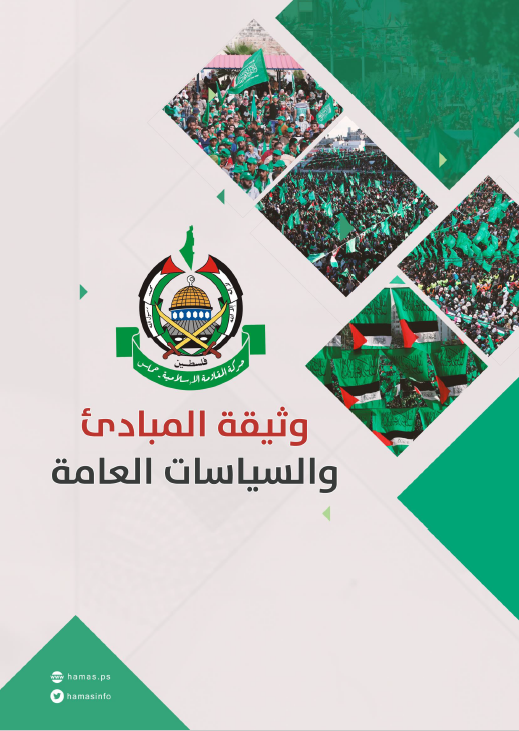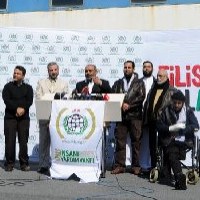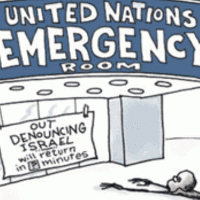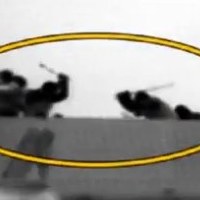![]()
Monday, May 8, 2017
First published by the Meir Amit Intelligence and Terrorism Information Center.
The goals of the political document and the background of its publication

The front page of Hamas’s new political document (Arabic version), or, to use its full name: “A Document of General Principles and Policies”.
On May 1, 2017, Hamas published a political document entitled “A Document of General Principles and Policies” (hereinafter: the “Political Document”). This document, which includes 42 sections, was published on the Hamas website in two versions: an Arabic version and a version translated into English (see below). An examination of the two versions reveals that there are slight differences in the translation into English compared with the Arabic source, but no significant differences were found between them. The document was published at the end of Khaled Mash’al’s term as chairman of the movement’s political bureau and was presented by him at a press conference in Qatar (May 1, 2017).
The Political Document is intended to update the ideology and basic concepts that appeared in the 1988 Hamas Charter.[1] The document was aimed to adapt them to the current strategic reality, which has changed unrecognizably since the charter was written. The differences in the (Arabic) names of these documents — charter (mithaq) versus document (wathiqa) — are not semantic, since the term “charter” is more binding than “document”. The Political Document is short and seems more like a political platform than a basic ideological document. Nowhere in the document (or anywhere else) does it state that it replaces the Charter, which, in the ITIC’s assessment, remains a fundamental document expressing Hamas’s ideology and basic principles.
In the 30 years that have passed since the Charter was written, Hamas and the entire region have undergone dramatic changes, which Hamas was required to address. The formulation of a Political Document that would provide a response and update Hamas’s perceptions apparently took several years. The final wording was formulated at the end of Khaled Mash’al’s term in office, during which the nature of the Hamas movement changed dramatically.[2] Today’s Hamas is not just a “resistance” movement that is engaged exclusively with the armed struggle against Israel, but also a governmental body that must, on a day-to-day basis, address the increasing hardships of the residents of the Gaza Strip. Therefore, Hamas is required to carry out a policy (including terrorism against Israel) that takes the needs of the residents of the Gaza Strip into consideration.
The Political Document was published during a period of change of leadership in Hamas, at a time when the movement is in dire strategic straits: the Gaza Strip is in a severe economic crisis (exacerbated by the Palestinian Authority’s economic pressure); the confrontation with the Palestinian Authority and Fatah is worsening; Hamas’s relations with Egypt and Saudi Arabia have deteriorated; difficulties have arisen in its relations with Iran in light of the civil war in Syria; and in the international arena it is almost completely isolated.Against this background, the new Political Document was intended to assist Hamas’s efforts to emerge from its isolation and solve its difficulties, first and foremost in the internal Palestinian arena, in Hamas’s relations with Egypt and the Arab world, and in its relations with Western countries.
An analysis of the Political Document clearly shows that there has been no change in Hamas’s basic ideology and principles, which are based on an uncompromising effort to destroy Israel through violence and terrorism, even if this is carried out in stages (presenting conditional willingness to establish a Palestinian state within the 1967 borders). The adjustments, changes and additions that appear in the Political Document are intended to present the appearance of Hamas’s renewal and adaptation to the current reality, but without any significant change in the principles and basic perception that constitute the core of the Document.[3]
The rigid fundamental perceptions that appear in the document
An examination of the text of the Political Document reveals that Hamas’s hard-core ideology and basic perceptions regarding the conflict with Israel, which have been expressed in the Hamas Charter, have not changed significantly over the past 30 years. They constitute the core of the new Political Document, which discusses them at length. However, Hamas omitted several problematic sections that appear in the Charter, changed a number of sections, and updated additional sections in order topresent a façade of flexibility and the adaptation of its positions to the needs of the new reality (see details below).
The rigid basic positions that appear in the Political Document are especially prominent in all matters pertaining to the Israeli-Palestinian conflict. Following are five of them:
- All of Palestine belongs to the Palestinian people:the sections dealing with “the Land of Palestine” (Sections 2, 3 and 20) state that all of Palestine belongs to the Palestinians, and the thieving “Zionist entity” has no right to it whatsoever. The borders of Palestine are “from the River Jordan in the east to the Mediterranean in the west, from Ras Al-Naqurah [Rosh Hanikra] in the north to Umm Al-Rashrash [Eilat] in the south.” The land of Palestine constitutes an integral, indivisible territorial unit. The Document states that it is strictly forbidden to give up any part of the land of Palestine and struggle until its full and complete liberation.
- Jerusalem (called “Beit al-Maqdis” in the Arabic document) is the capital of Palestine and belongs exclusively to the Palestinian people and to the Arab and Islamic Ummah [nation] (Sections 7, 10 and 11). In Hamas’s view, there is no West-Jerusalem and East-Jerusalem, all of Jerusalem is Palestinian, and “not one stone of Jerusalem can be surrendered or relinquished.” The Document states that all the measures undertaken by Israel (the “occupiers”) in Jerusalem are fundamentally null and void. According to the Document, Israel has no right whatsoever to Al-Aqsa Mosque (and, implicitly, to the entire Temple Mount). The Document contains no mention whatsoever of the thousands of years of Jewish presence in Jerusalem, and in all of Israel, even before the advent of Islam.
- The “right of return” of the Palestinian refugees: The “right” of the Palestinians to return to the lands from which they were deported in 1948 and 1967 (Sections 12 and 13). The Document states that this is a “natural right, both individual and collective” that “cannot be dispensed with by any party, whether Palestinian, Arab or international. Compensation to the Palestinian refugees for the harm they have suffered as a consequence of banishing them and occupying their land is an absolute right that goes hand in hand with their right to return. They are to receive compensation upon their return, and this does not negate or diminish their right to return.” The meaning of this section is that the “right of return” cannot be canceled or violated in any political agreement.
- Denying the legitimacy of the Zionist movement [the document also uses the term “Zionist project”] and the State of Israel (Sections 14-23): In this part, the Zionist movement is described at length as racist, aggressive, and colonial, and the “Israeli entity” is described as its plaything. The Document states that the Zionist movement is the enemy of the Arab and Islamic Ummah, posing a grave threat to its security and interests, and also poses a danger to international security and peace and to mankind and its interests and stability. Therefore, “there shall be no recognition of the legitimacy of the Zionist entity.” The Document also states that all the international community’s resolutions on Palestine, including the Balfour Declaration and the UN Palestine Partition Resolution, are null and void. The Document also rejects the Oslo Accords, including their addenda and commitments, because they violate the inalienable rights of the Palestinian people and are detrimental to their interests, “especially security coordination (collaboration) with Israel.”
- The active resistance (al-muqawama) and jihad are the Palestinians’ “legitimate right” in their struggle to “liberate Palestine” (Sections 23-26). The active armed resistance and jihad (i.e., the use of violence and terrorism as the main strategy for the “liberation of Palestine”) will remain a “legitimate right” and a strategic (implicitly preferred) choice for protecting the “rights” of the Palestinian people. However, the Document states that the way the armed activity is conducted may change from time to time. As part of this armed activity, there may be periods of escalation or lulls, or the use of various and sundry methods of action, all in accordance with the circumstances and the changing reality.
Changes, updates and adjustments in the Document
The new Political Document omitted problematic sections that appear on the Hamas Charter, updated and changed other sections, and added sections to which there was no reference in the Charter. Following are the main changes and updates:
- Hamas’s identity: Hamas defines itself at the beginning of the Document as a “Palestinian Islamic national liberation and resistance movement”. “Its frame of reference is Islam” (Section 1). Its purpose is “the liberation of Palestine” and confrontation with the Zionist project. Hamas combines Palestinian nationalism and Islam. However, Palestinian nationalism is highly emphasized in the Document. The Document also discusses the nature of Islam in which Hamas allegedly believes. It states that Islam which Hamas believes in is the “religion of peace and tolerance,” a justly balanced Islam that takes the “middle way,” which is opposed to any form of religious extremism (alluding to the Salafi jihadists and to ISIS). Particularly important is the omission of Section 2 of the Charter, which states that Hamas is the Palestinian arm of the Muslim Brotherhood movement. In the ITIC’s assessment, this omission does not mean that Hamas has disassociated itself from the Muslim Brotherhood movement (and this was also not stated by Hamas), but rather an attempt by Hamas to downplay the close relationship with them.
- Conditional acceptance of the establishment of a Palestinian state in the 1967 borders: in Section 20 of the Document of Principles, which received extensive media coverage, Hamas expresses conditional agreement to the establishment of an independent Palestinian state, whose capital is Jerusalem, in the June 4, 1967, lines.[4] The condition is that the reward for establishing such state will not include any recognition of Israel (“the Zionist entity”) or renunciation of any Palestinian “right.” It was stated that even in the scenario of the establishment of such state, the goal must remain the complete “liberation of Palestine,” from the Jordan River to the Mediterranean, and the return of the Palestinian refugees to their homes (i.e., the destruction of the State of Israel). The Document states that Hamas will consider a conditional establishment of such Palestinian state in the 1967 lines because it understands that such a formula is within the national Palestinian consensus.
- “Moderating” the explicit call for the elimination of the State of Israel, without renouncing it. At the beginning of the Hamas Charter, there is a quote by Hassan al-Bana, the founder of the Muslim brotherhood movement, that “Israel will rise and continue to exist until Islam wipes it out, as it wiped out what preceded it.” This explicit call for the elimination of Israel was replaced with a categorical negation of the legitimacy of the State of Israel, and the desire to “liberate” the entire land of Palestine and to establish a Palestinian state on its entire territory, without the existence of an Israeli political entity (the Document does not refer to the question of what will become of Israel’s inhabitants upon the establishment of the Palestinian state and the destruction of the State of Israel).
- The political document distinguishes between the struggle against Zionism and the State of Israel, and the attitude towards Jews as a religion. The paragraph in the Charter calling for joining efforts for the campaign against the Jews was not included in the Document. The Political Document states that “Hamas affirms that its conflict is with the Zionist project, not with the Jews because of their religion. Hamas does not wage a struggle against the Jews because they are Jewish, but wages a struggle against the Zionists who occupy Palestine” (Section 16). Anti-Semitic sections that appear on the Charter were also omitted, with the intention of repelling accusations as if Hamas is an anti-Semitic movement (the Charter includes anti-Semitic myths based on the Protocols of the Sages of Zion, on Jewish rule on the media, films, and education). The Political Document states that anti-Semitism and persecution of the Jews are phenomena related to the European history rather than to the history and legacy of the Arabs and Islam.
- Willingness to show flexibility regarding the manner of conducting the terrorist campaign (active “resistance”) against Israel, without renouncing the principle of armed resistance as an (implicitly preferred) strategic choice for the “liberation of Palestine.” Hamas rejects any adverse effect on the “resistance” and its weapons. Yet it agrees that there might be changes in its nature from time to time. As according to Hamas’s perception, there may be periods of escalation in the terror campaign against Israel and periods of lull, all in accordance with the circumstances and the changing reality. All of this is within what the Document dubs the process of conducting the struggle (thus, Hamas gives legitimacy to its agreement to the current lull in the Gaza Strip).
Assessment of the purpose of the changes and adjustments
In the ITIC’s assessment, the changes and adjustments that appear in the Political Document are not intended to assist in starting a political process for the resolution of the Palestinian-Israeli conflict. This is true as Hamas is well aware that its intransigent fundamental position is a non-starter for the promotion of considerable communication with Israel and even with the international community. These changes and adjustments are intended to achieve political and media-related purposes first and foremost in the internal Palestinian arena. In addition, they are intended to achieve political profits for Hamas vis-à-vis Egypt and the Arab world and vis-à-vis Western countries, in order for Hamas to break out from its isolation and ease the pressure exerted on it.
Particularly important is Hamas’s attention to the internal Palestinian arena:
- Hamas is interested to show ostensibly “soft” formulas to demonstrate that its hardcore ideology does not constitute an obstacle to internal Palestinian reconciliation and present willingness to promote possible reconciliation on a common political basis. This is not a novel tactic. Expressions of conditional willingness to establish a Palestinian state within the 1967 borders and willingness for jointly conducting terrorist activity (“resistance”) with the Palestinian Authority and Fatah also appeared in the past, in the context of communication towards internal Palestinian reconciliation.
- Thus, for instance, following the signing of the internal Palestinian reconciliation agreement (May 4, 2011), senior Hamas figures made it clear that they had no objection to the PA’s political move in the UN that would lead to the establishment of a Palestinian state within the 1967 borders. This was on condition that it would not necessarily be accompanied by recognition of Israel and the renunciation of the “right of return” of the Palestinian refugees. Therefore, senior Hamas figures explained, they would allow the Palestinian Authority to go forward with its move at the UN in September 2011, although they didn’t believe in it (“empty words,” “political circus”). Senior Hamas figures also made it clear that in principle, Hamas adheres to the way of “resistance” (i.e., terror); however, it is willing to reach an agreement with the Palestinian Authority as to the manner of conducting the “resistance.”[5]
The omission of the connection with the Muslim Brotherhood movement from the Political Document and the emphasis on moderate Islam to which Hamas allegedly adheres were intended to distinguish between Hamas and the Salafi jihadists mainly (but not exclusively) to please Egypt, which declared the Muslim Brotherhood movement a terrorist organization. They were also intended to present Hamas to the Arab world and to the international community as a moderate Islamic movement. The omission of the anti-Semitic sections that appear in the Hamas Charter; the distinction between the struggle against Zionism and the attitude towards Jews; presenting the struggle against Israel as a Palestinian national struggle; the conditional willingness to establish a Palestinian state within the 1967 lines — all of these, in the ITIC’s assessment, were intended to improve Hamas’s relations with Western countries and the entire international community and to motivate the international community to exert pressure on Israel. Against this background, Hamas may soon be expected to engage in “smile politics” addressed at the Arab world and Western countries (first and foremost the United States), in order to gain political and PR profits from the new document.[6]
Downloads
The ITIC will systematically compare the wording of the Political Document with that of the Hamas Charter, and the findings of the study will be published separately.
The Political Document:
- Download Hamas’s Arabic version here.
- Download Hamas’s English version here.
The 1988 Hamas Charter:
- Download the 1988 Hamas Charter Arabic version here.
- Download the 1988 Hamas Charter English version here.
- Download the ITIC’s analysis of the 1988 Hamas Charter here.
![]()
Notes:
[1] The text of the Charter and an analysis of its sections appear in the ITIC’s bulletin from May 5, 2006 (see download above).
[2] In his speech in Qatar (May 1, 2017), Khaled Mash’al said that in the past two years, Hamas had begun an in-depth discussion aimed at formulating the final wording of the document. This wording was presented to Hamas’s supreme institutions (the Shura Council and the Political Bureau) and approved by them. According to Khaled Mash’al, after the document was formulated, the Hamas leadership met with international legal experts to ensure that the document would be in line with international law (i.e., according to Mash’al, the destruction of the State of Israel and the adoption of a strategy of violence and terrorism are enshrined in international law). According to Khaled Mash’al, that is why the document was translated by Hamas into English.
[3] The reactions to the document in the Arab and international arena, including in the Palestinian arena and in Egypt, range from presenting it as the expression of a significant change in Hamas’s positions to considering it a tactical move and a political maneuver designed to Hamas’s own needs. A detailed discussion of the reactions will be distributed in a separate document.
[4] The Political Document uses the term “lines” (khutut) rather than “borders” (hudud). In the ITIC’s assessment, this was done in order to stress the temporary nature of the 1967 lines and the fact that they are ceasefire lines rather than permanent borders between two states.
[5] See the ITIC’s Information Bulletin from May 15, 2011: “Statements made by senior Hamas figures since the internal Palestinian reconciliation agreement attempt to present a moderate image while restating Hamas’ refusal to recognize Israel or accept the International Quartet’s conditions, continuing the “resistance” (i.e., terrorism), and drawing Fatah back into the cycle of violence”. See also the ITIC’s Information Bulletin from April 23, 2014: “Following the Fatah-Hamas reconciliation, Hamas may maneuver between adherence to its fundamental positions and its desire to benefit from the agreement which may serve its internal political and media purposes”.
[6] The first indication of this is an interview granted by Khaled Mash’al to CNN in Doha (May 3, 2017), on the eve of President Trump’s meeting with Mahmoud Abbas. In the interview, Mash’al said that the Political Document gives Trump a “historic opportunity” to exert pressure on Israel and find an “equitable solution” for the Palestinian people. According to Mash’al, Israel does not recognize the Palestinian rights. When the Palestinians have their own sovereignty, a state of their own, they will be able to make their own choice, without external pressure. Khaled Mash’al called on President Trump to exert pressure on Israel because of its “intransigence” with reference to the settlements and its occupation of the West Bank. According to him, this is the key for achieving a “real and equitable peace in the region” (CNN, Doha, May 3, 2017).



 RSS
RSS










Latest Comments
Hello Mike, Thank you for your positive feedback to the article. I felt there wasn’t too much critical analysis of ...
Thanks for this considered and well constructed article. A follow up article on the manner in which the editorial contro...
THE CLUELESSNESS OF CLAIMING THAT OBAMA'S MIDDLE EAST POLICIES WERE A FAILURE CANNOT BE FURTHER FROM THE TRUTH, WHAT THE...
As long as Obama is the president of the usa do not trust the us government......
Thank you for an good read....